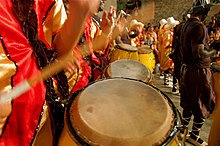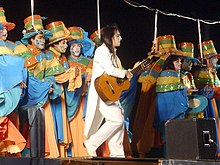Uruguayan Carnival
This article has multiple issues. Please help or discuss these issues on the talk page. (Learn how and when to remove these template messages)
|
| Uruguayan carnival | |
|---|---|
 Uruguayan Carnival in 1915 (Montevideo) | |
| Genre | Festival |
| Begins | Mid-January |
| Ends | Late February |
| Country | Uruguay |
| Activity | Dance parade |
Uruguayan Carnival is a festival that takes place every year in Uruguay from mid January to late February. It is related to candombe, Murga and . It has evolved into a dance parade in which different comparsas play the drums and dance to the music at "Desfile Inaugural del Carnaval" and parade. The biggest carnival celebrations are in the capital Montevideo and can last up to 40 days, involving a series of cultural events such as dance parades in the streets, street stages called "tablados" and an artistic contest in the "Teatro de Verano" (Summer Theatre) in Montevideo.[1] Carnival in Montevideo is very different from carnival celebrations in Rio de Janeiro in Brazil.[2]

History[]
Origins[]
The background of the Uruguayan Carnival come from Europe, where in different contexts (the celebration of the harvest or a religious festival) it served as a space for meeting people and creating a space for individual and collective freedom. Already, on Uruguayan soil, in colonial times, on the days of Carnival, Christmas, and New Year, Montevideans (black slaves) were covered with bright and gaudy robes and went outside to the city walls. They were allowed to sing their songs and perform dances. Some common practices of carnival in Europe, bran and flour shed, shed water syringes, throwing eggs, oranges, or other objects were imported into Uruguay. The importance of some of these practices by the first inhabitants of the city of Montevideo led to the carnival celebrations. According to Juan Carlos pattern, it is possible that in 1860, when two sources called "Wells of the King", the "van guerrillas" were disseminated and conform the first carnival practices were built.
Carnival in Montevideo[]

Sociedades de Negros y Lubolos[]
In Uruguay, las Sociedades de Negros y Lubolos, also called comparsas are a group of persons who sing and dance candombe music. The word lubolos makes reference to the white people in blackface that dresses as black people in the past in order to take part in the dance parades during colonial times, not as mockery, but as tribute of their lives and recognition of the past. It consists of a group of dancers, a group of drummers named and special characters such as , y [3]
Murga[]
Murga is a theatrical-musical genre that consists of a chorus of 14 to 17 people with murga drums. They sings songs and do some acting in between with impersonators and a mockery of events that criticizes politicians and society. People in murgas have their faces painted and usually are in bright outfits. Lyrical content is based on a particular theme, chosen by the group, which serves to provide commentary on events in Uruguay or elsewhere over the preceding year. Consequently, murga is used as a form of resistance. For example, during the dictatorship in Uruguay in the 1970s, groups like became known for their left-wing tendencies, subversive commentary and oppositional stance.[4]

Parodists[]
They create humorous situations called parodies, based on a well-known novel or film or even some famous character in history.
Magazines[]
They are a group of people dancing and singing pop music with different lyrics about human nature and personal problems.
Escolas de Samba[]
in Uruguay have a tradition too, principally in places like Artigas and Montevideo. The genre of these groups are Samba with Brazilian percussion, dancers and a chorus of people singing the . The main escola de samba in Montevideo was Aquarella founded by Mr. who lives for many years in Rio de Janeiro. From Aquarela, many others Escolas de Samba was founded like Asabranca and Imperatriz. In 2017, Imperatriz was the winner group in the annual samba parade in Montevideo city and Barrio Rampla was the winner in Artigas city.
External links[]
- Carnaval del Uruguay
- Portal de Murgas
- Historia de la Murga
- Carnaval del Futuro
- Carnaval de Montevideo: La mayor fiesta de la cultura y la participación popular
- Directores Asociados de Espectáculos Carnavalescos Populares de Uruguay
- Escola de Samba Imperatriz (Uruguay)
References[]
- Afro-Uruguayan culture
- Candombe
- Masterpieces of the Oral and Intangible Heritage of Humanity
- Carnivals in Uruguay
- Summer events in Uruguay
